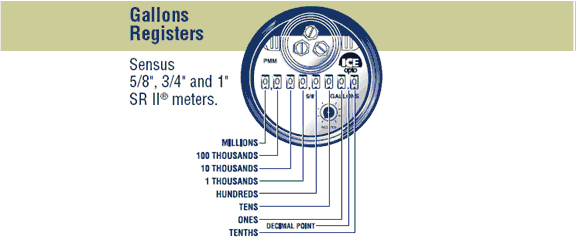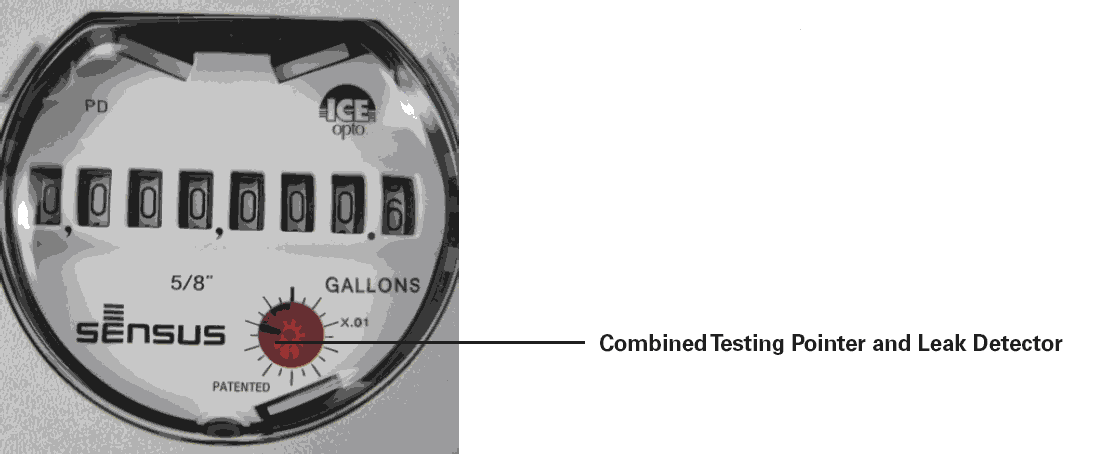There are many possible causes and potential solutions for leaks in your home or business water distribution system. The most problematic are leaks that are slow and “secretive” – typically near a drain or outside where they are not readily detected. These types of leaks are typically in toilets, water softeners, crawl spaces, outside hoses or lawn irrigation/sprinkler systems, or other places where a leak might not be readily evident. Below we will address a few examples of common problems experienced by our customers.
To help locate a leak, you first need to locate your water meter. The water meter is usually located in the basement somewhere on the front wall of the house, or perhaps in a laundry room or in a utility closet. Once you have located your meter, look at the low flow dial located on the register head. If the low flow dial is moving it is probable that you have a leak. If you are sure that there is not any water being used in the building and the meter is moving, we suggest you check the following:
- Check all areas of your home or business and listen for running water sounds.
- Shut off every water device. Check your water meter. It should not indicate flow.
- Next, lift the lids on all toilet tanks and see if the water level is too high and is running into the overflow tube. Make corrections or repairs as needed. Also check the toilet bowl for running or leaking water. Place a few drops of food coloring in the tank and wait approximately 15 minutes. If the food coloring seeps into the bowl this indicates repairs are needed. (NWAA can supply dye tablets if you need them. Contact the NWWA Customer Service Department.)
- Check to see if there is any water moving around in the toilet bowl. Each toilet has a shut off valve on the supply line. Shut off all of the toilets and wait approximately 5 minutes. Return the supply of water to each toilet, one at a time, and listen to hear which toilet fills. If it does, it is an indication of a leaking toilet.
- Check your water softener if you have one. These sometimes leak internally or externally allowing water to continue to pass through the system needlessly. If you can shut the water off to the softener, you can then recheck the water meter to see if this isolates the problem.
- Check your hot water heater and/or hot water heat system (when applicable) to ensure that it is not leaking or that the overflow valve is not leaking. If so, repair.
- Check all outside hose bibs to make sure you are not losing water through hoses or outside fixtures.
- If you have an underground sprinkler system, make sure it is functioning properly and not leaking somewhere outdoors. (Again, shut it off and recheck the meter.)
In summary, your water meter is a mechanical device which should NOT move unless water is passing through. It is worth your time to find any leaks in your home or business!
For additional information call our Customer Service Representatives at 215-699-4836.
The problem of electrical shock has long been a recognized safety concern for the Authority’s meter service personnel. Water meters often become electrically charged because electricians and homeowners ground electrical wiring to the water pipes. NWWA policy discourages this practice and specifies that a bonding wire be installed on the water line around the meter. This electrical bypass ensures that the electrical ground will not be broken when the meter is removed from the water line.
Many types of electrical failures in the home including malfunctioning appliances or deteriorating wire insulation can charge the meter by making the water line an active electrical ground. Home and business owners should periodically inspect the bonding wire for continuity and corrosion and, if necessary, repair or replace it.
We suggest that everyone in your house know the location of your shut-off valve before an emergency happens. The shut off valves for the supply of water to the home are located on either side of your water meter. We offer a free valve ID tag…call us at 215-699-4836 to receive one.

